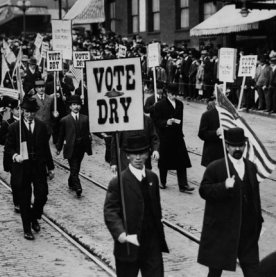 At my local CVS Pharmacy in Virginia, I can buy dental floss, nail polish, aspirin, and mailing envelopes. I can also purchase booze: Yellow Tail Merlot, an orange-labeled substance claiming to be sangria, and three flavors of Bud Light, just for starters. A few blocks away, a neighborhood store hawks Dubonnet, Belgian ales, hard cider, and nine kinds of Russian wine. If I drive a few minutes by car, I reach a shop whose aisles glitter with brands of liqueurs, distilled spirits—even absinthe.
At my local CVS Pharmacy in Virginia, I can buy dental floss, nail polish, aspirin, and mailing envelopes. I can also purchase booze: Yellow Tail Merlot, an orange-labeled substance claiming to be sangria, and three flavors of Bud Light, just for starters. A few blocks away, a neighborhood store hawks Dubonnet, Belgian ales, hard cider, and nine kinds of Russian wine. If I drive a few minutes by car, I reach a shop whose aisles glitter with brands of liqueurs, distilled spirits—even absinthe.
This intoxicating bounty seems normal—almost necessary. So I have often wondered how on earth America managed to pass, and live with, the Eighteenth Amendment, which banned the manufacture and sale of alcohol. (The amendment was ratified in 1919, took effect in 1920, and was repealed in 1933 by the Twenty-first Amendment.)
Now I’ve watched the three-part, five-and-a-half hour documentary Prohibition, premiering on PBS on October 2, 3, and 4, and I wonder no longer. Celebrated director Ken Burns and his partner, Lynn Novick, have crafted a brisk and absorbing film that brims with insights, not only into the broader cultural and economic forces that turned the United States—in theory—dry for thirteen years, but also into the episode’s long-term legacy.
Along the way, the documentary paints vivid portraits of idiosyncratic idealists and opportunists whose reputations are now gathering dust in the wine cellar of national memory. Who now recalls Carrie Nation, the Women’s Christian Temperance Union zealot known for vandalizing barrooms with a hatchet? Or Wayne Wheeler, who turned the Anti-Saloon League into a political machine so ruthlessly efficient it might spark envy in Grover Norquist? Or Roy Olmstead, the onetime Seattle cop known as the “Good Bootlegger”? Or Mabel Walker Willebrandt, the high-powered U.S. assistant attorney general in the 1920s, who gained the nickname “Prohibition Portia”?
The stories of these strong-willed personalities, and the analysis of the ideas and passions that motivated them, unspool in the smooth, measured, handsome format we have come to expect from Burns’s films: the camera that zooms in, or up, on black-and-white photos, giving movement to static images; the stately voiceovers by eminent actors; and the cameos by articulate experts. (The talking heads here include Justice John Paul Stevens; writer Pete Hamill; former New York Times public editor and Prohibition historian Daniel Okrent; and scholar Martin E. Marty.) Punctuating the stream of elucidation—and balancing the eye-catching historic photos of people smashing bottles and kegs—are atmospheric staged shots of clear and bourbon-colored fluids gushing into ice-laced, condiment-trimmed glasses. Burns, Novick, and co-producer Sarah Botstein evidently had a budget line for olives and maraschino cherries.
Like the liquids tumbling into that crystal ware, the documentary reveals, Americans’ dreams, fears, and biases sluiced into the temperance debate. Concern about alcohol abuse, of course, did fuel the Prohibitionist movement. But, additionally, as rural folk began to associate cities and slums with saloons and liquor-exacerbated social problems (poverty, crime, domestic abuse), teetotalist sentiment became a stand-in for the standoff between urban and country life. And as immigrants flooded into the United States in the nineteenth and early twentieth centuries, bringing their own national drinking habits with them, xenophobia and angst about national identity found an outlet in anti-alcohol fervor. The Ku Klux Klan was a Prohibition booster.
Burns and Novick’s film notes the anti-Catholic prejudice that sometimes tinged this period: When Prohibition opponent Al Smith, who happened to be Catholic, ran as the Democratic nominee for president in 1928, rumors circulated that, if elected he would build an underwater tunnel to the Vatican.
The documentary observes that Prohibition—which unintentionally nurtured criminal gangs and made lawbreaking seem imperative, and even thrilling, to otherwise honest folk—was a case study in the difficulties and dangers of legislating human morality. No matter what your political leanings, the story will likely call to mind recent developments in America’s culture wars, including the rise of the Tea Party.
Marty suggests that the failure of Prohibition sparked a search for a “new moral framework for improving America without quite so much pride, arrogance, and self-assurance.” (We searched, but did we find?) The rise and fall of the Eighteenth Amendment also reshaped gender roles: female activists, the backbone of the temperance movement, found the crusade to be, in a contemporary’s words, “a baptism of power and liberty.”
The Prohibition years brought further emancipation to the distaff set, this film maintains: before 1920, women had hesitated to drink in public alongside men, but the glamorously illicit atmosphere of speakeasies dissolved that taboo. As a result, ninety years later, I don’t need to think twice about ordering an inebriant in public, even if I could be kicking back at home with a CVS Chardonnay.
Related: Celia Wren's interview with Ken Burns
Please email comments to [email protected] and join the conversation on our Facebook page.
Share
Previous Story
We Hold Which Truths?
Next Story
From Nightmare to Tragedy

